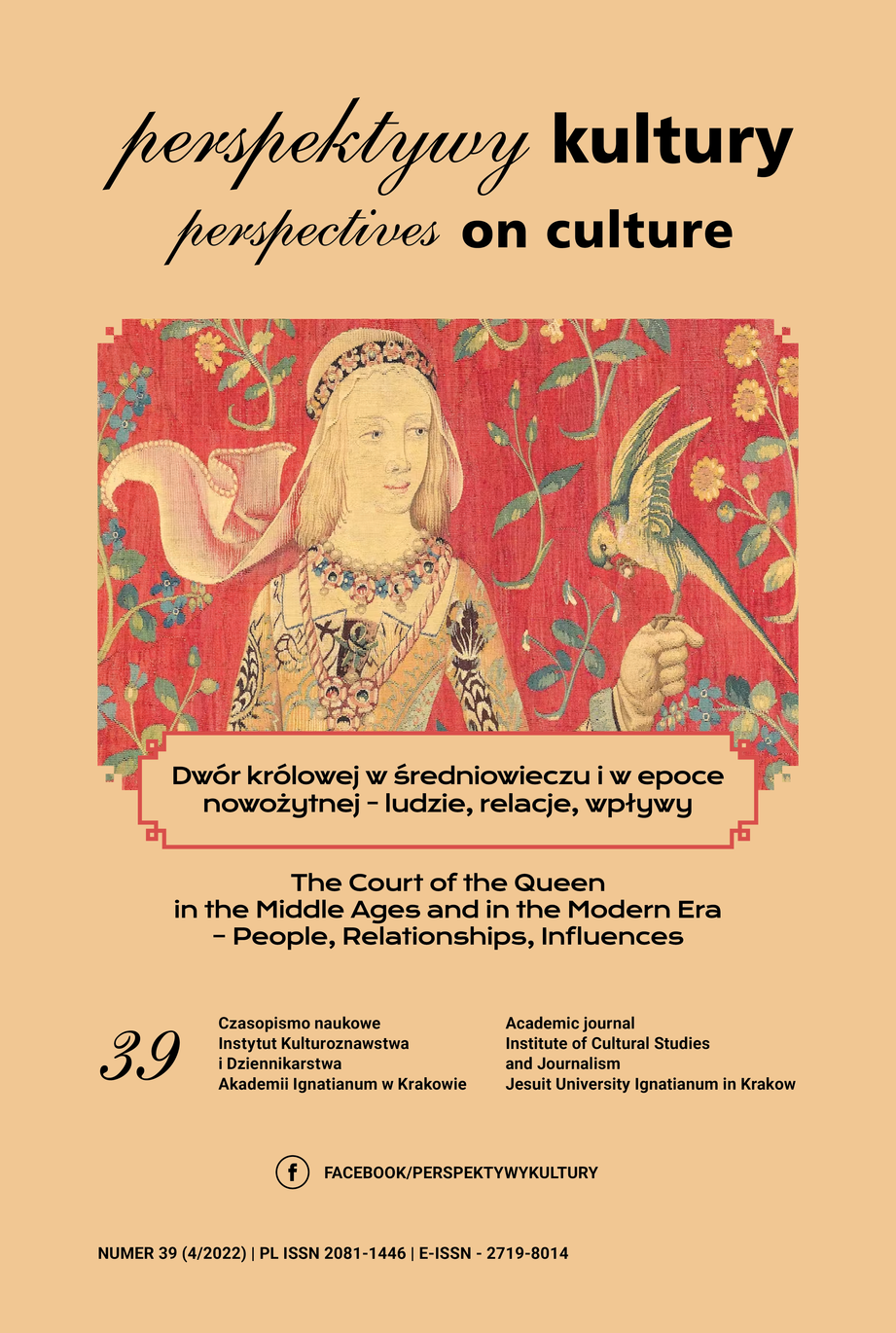They Serve, They Watch, They Criticize. About the Servants of Saint Elizabeth of Turin
Abstract
In the article, the author discusses the daily functioning of Saint Elizabeth of Turin’s servants. The article’s conclusions are based on Libellus de dictis quatuor ancillarum Sr. Elisabeth confectus – a testimony of the queen’s companions, which was written for the needs of her canonization process. Although hagiographic patterns which are present in Libellus, one can find interesting information about the daily functioning of a landgrafine. The analysis of her lifetime shows that the choices of that holy ruler had a huge impact on her household. It had to adapt to Elizabeth’s way of life, which was filled with strict customs, rules and sacrifices. What is more, it was obliged to participate in her strife towards an ideal Christian life. For example, it accompanied its landgrafine during the caring for lepers and imitated her in the ascetic practice of fasting. On the one hand, the source informs that the servants were doing it of their own will, on the other, it depicts their reluctance towards the acts of mercy. Based on the assumption that the emotions and experiences of the testifying persons percolate through the established pattern of hagiographic works.
References
Huyskens, W. (red.). (1908). Libellus de dictis quatuor ancillarum s. Elisabeth confectus. W: Quellenstudien zur Geschichte der hl. Elisabeth van Thüringen. Marburg: N.G. Elwert.
Kętrzyński, W. (red.). (1884). Vita et miracula sancte Kyngae ducissae Cracoviensis. W: Monumenta Poloniae Historica, t. 4. Lwów [s.n.]
Wolf, K.B. (2011). The Life and Afterlife of St. Elizabeth of Hungary: Testimony from her Canonization Hearings. Oxford: Oxford University Press.
Bańka, A. (2002). Społeczna psychologia środowiskowa. Warszawa: Scholar. Bartlett, R. (2013). Why Can the Dead Do Such Great Things?: Saints and Worshippers from the Martyrs to the Reformation. Princeton: Princeton University Press.
Bynum, C.W. (1987). Holy Feast and Holy Fast. The Religious Significance of Food to Medieval Women. California: University of California Press.
Czarnecki, P. (2004). Lucyferianizm niemiecki w XIII w. zapomniany odłam kataryzmu. Studia Historyczne, 74, nr 1, 3–19.
Elliott, D. (2004). Proving Woman: Female Spirituality and Inquisitional Culture in the Later Middle Ages. Princeton: Princeton University Press.
Fischer, M. (2004). Konrad von Marburg und die Anfänge der Inquisition in Deutschland. Jahrbuch der Hessischen Kirchengeschichtlichen Vereinigung, 55, 161–195.
Geese, U. (1981). Die Reliquien der Elisabeth von Thüringen im Interesse des Ketzerpredigers Konrad von Marburg. W: K. Clausberg, K. Dieter Kimpel, H.J. Kunst i R. Suckale (red.), Bauwerk und Bildwerk im Hochmittelalter. Anschauliche Beiträge zur Kulturund Sozialgeschichte. Gießen: Anabas, 127–140.
Klaniczay, G. (2004). Proving sanctity in the canonization processes (Saint Elizabeth and Saint Margaret of Hungary). W: G. Klaniczay (red.), Procès de canonisation au Moyen Âge : aspects juridiques et religieux. Rome: École Française de Rome, 117–148.
Klaniczay, G. (2007). Holy rulers and blessed princesses: dynastic cults in medieval central Europe. Cambridge: Cambridge University Press.
Michalski, M. (2004). Kobiety i świętość w żywotach trzynastowiecznych księżnych polskich. Poznań: Wydawnictwo Poznańskie.
Nirenberg, D. (1996). Communities of Violence: Persecution of Minorities in the Middle Ages. Princeton: Princeton University Press.
Panuś, K. (2007). Święta Elżbieta. Kraków: Wydawnictwo Apostolstwa Modlitwy.
Patschovsky, A. (1981). Zur Ketzerverfolgung Konrads von Marburg. Deutsches Archiv für Erforschung des Mittelalters, 37, 641– 693.
Radzimiński, A. (2008). Św. Elżbieta z Turyngii – europejski wymiar średniowiecznej kobiety. W: M. Mróz, J. Perszon i K.Ż. Sztylc (red.), Źródła duchowości Europy. Święta Elżbieta – świadectwo miłości miłosiernej. Toruń: Wydawnictwo Naukowe Uniwersytetu Mikołaja Kopernika, 41–54.
Radzimiński, A. (2015). Średniowieczny żywot jako wyzwanie dla mediewisty: św. Elżbieta z Turyngii. W: R. Czaja i K. Kopiński (red.), Piśmienność pragmatyczna – edytorstwo źródeł historycznych – archiwistyka. Toruń: Towarzystwo Naukowe w Toruniu, 71–87.
Reber, O. (2006). Elisabeth von Thüringen: Landgräfin und Heilige. Eine Biografie. Regensburg: Verlag Friedrich Pustet.
Vahl, W. (2007). Konrad von Marburg, die Hl. Elisabeth und der Deutsche Orden. Marburg: Hessisches Staatsarchiv Marburg.
Vauchez, A. (1996). Duchowość średniowiecza, tłum. H. Zaremska. Gdańsk: Wydawnictwo Marabut.
Vauchez, A. (red.). (2017). Sainte Élisabeth de Hongrie. Princesse, servante, sainte. Vies et documents. Paris: les Éditions franciscaines.
Zupka, D. (2016). Ritual and Symbolic Communication in Medieval Hungary under the Árpád Dynasty. Boston: Brill.
Copyright (c) 2022 Jesuit University Ignatianum in Krakow

This work is licensed under a Creative Commons Attribution-NoDerivatives 4.0 International License.
Autor, zgłaszając swój artykuł, wyraża zgodę na korzystanie przez Wydawnictwo Uniwersystet Ignatianum z utworu na następujących polach eksploatacji:
- utrwalania utworu w formie papierowej, a także na nośniku cyfrowym lub magnetycznym;
- zwielokrotnienia utworu dowolną techniką, bez ograniczenia ilości wydań i liczby egzemplarzy;
- rozpowszechniania utworu i jego zwielokrotnionych egzemplarzy na jakimkolwiek nośniku, w tym wprowadzenia do obrotu, sprzedaży, użyczenia, najmu;
- wprowadzenia utworu do pamięci komputera;
- rozpowszechniania utworu w sieciach informatycznych, w tym w sieci Internet;
- publicznego wykonania, wystawienia, wyświetlenia, odtworzenia oraz nadawania i reemitowania, a także publicznego udostępniania utworu w taki sposób, aby każdy mógł mieć do niego dostęp w miejscu i czasie przez siebie wybranym.
Wydawca zobowiązuje się szanować osobiste prawa autorskie do utworu.





